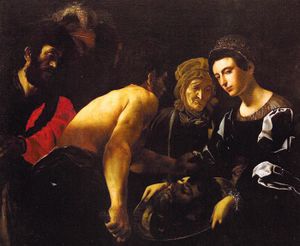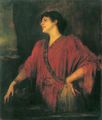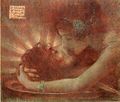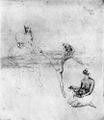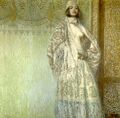Difference between revisions of "Category:Salome (subject)"
| Line 30: | Line 30: | ||
Research on Salome however is limited by the paucity of historical sources and the legendary nature of the Gospel account. Scholars have rather focused on the study of the Salome legend and its ramifications in literature and the arts. | Research on Salome however is limited by the paucity of historical sources and the legendary nature of the Gospel account. Scholars have rather focused on the study of the Salome legend and its ramifications in literature and the arts. | ||
==== Salome === | |||
The story of Salome is recorded in Islamic sources, as well. | |||
====Salome, in fiction==== | ====Salome, in fiction==== | ||
| Line 38: | Line 42: | ||
* [[Gabriele Boccaccini]], University of Michigan | * [[Gabriele Boccaccini]], University of Michigan | ||
==Salome, in ancient sources== | ==Salome, in ancient sources== | ||
Revision as of 09:10, 12 January 2021
Salome (1st century CE) was the daughter of Herodias and Herod II, and the step-daughter of Herod Antipas.
< Events : Death of John the Baptist >
< Scholarship : Salome (research) -- Salome (sources) >
< Salome (fiction) : Salome (art) -- Salome (cinema) -- Salome (dance) -- Salome (literature) -- -- Salome (music) -- Salome (theatre) >
- San Giovanni Battista (St. John the Baptist / 1675 Stradella / Ansaldi), oratorio
- Hérodiade (Herodias / 1881 Massenet / Milliet, Grémont), opera
- (++) Salomé (Salome / 1893 Wilde), play
- (++) Salome (1905 Strauss / Lachmann), opera
- Salomé (1908 Mariotte / Wilde), opera
- This page is edited by Gabriele Boccaccini, University of Michigan
Overview
From the historical point of view, Salome is part of the scion of powerful and politically engaged women that characterized the House of Hasmoneus (and the House of Herod), from Queen Salome Alexandra to Alexandra the Hasmonean, Mariamne, Herodias, Berenice, Drusilla, and others.
Josephus introduces Salome as the daughter of Herod II and Herodias. Her paternal grandparents were Herod the Great and Mariamne II, while another son of Herod the Great, Aristobulus IV and his wife Berenice I were her maternal grandparents. She was thus related to both the House of Herod and the House of Hasmoneus.
After her mother's divorce and remarriage, Salome grew up as the step-daughter of her uncle Herod Antipas. Some legendary Christian accounts narrate of her involvement in the death of John the Baptist.
Still an adolescent, Salome was given as wife to her uncle Herod Philip, son of Herod the Great. A young widow, she remarried with Aristobulus of Chalcis, from whom she had three sons named Herod, Agrippa and Aristobulus (see Ant XVIII 136-137).
Nothing else is known about her life and death.
Research on Salome however is limited by the paucity of historical sources and the legendary nature of the Gospel account. Scholars have rather focused on the study of the Salome legend and its ramifications in literature and the arts.
= Salome
The story of Salome is recorded in Islamic sources, as well.
Salome, in fiction
The character of Salome has been subjected in fiction to a dramatic metamorphosis, from innocent child or indifferent teenager to powerful icon of morbid female seductiveness (and anti-Semitism). Salome is one of the most successful and recognizable characters from Second Temple Judaism in modern culture.
In medieval Christian iconography, Salome is portrayed as an innocent child, the passive instrument of her mother's revenge. By the 16th century, the character has matured into a teenager, now more indifferent than innocent to the drama in which she has been involved. The turning point is the second half of the 19th century when Salome is transformed into an Oriental beauty, fully self-conscious of her power of seduction. In the works of Oscar Wilde and Richard Strauss she becomes the epitome of the femme fatale, a sensual, morbid and sadistic character who destroys the men she loves.
- Gabriele Boccaccini, University of Michigan
Salome, in ancient sources
The character of Salome is mentioned both in Josephus and in the Gospels of Mark and Matthew.
The Gospels of Mark and Matthew (which do not mention her name or any other incidents in her life) suggest her (involuntary) involvement in the death of John the Baptist. They tell us that as a girl she danced before her uncle (and now step-father) Herod Antipas. At the instigation of her mother Herodias, she requested and obtained the head of John the Baptist as her reward from the king.
Josephus (who does not mention Salome in his account of the death of John the Baptist), in a genealogical list of the descendants of Herod the Great, talks briefly of her life as the daughter of Herod II and Herodias, and the step-daughter of Herod Antipas after her mother's divorce and remarriage. Salome was given as wife to her uncle Herod Philip, son of Herod the Great. A young widow, she remarried with Aristobulus of Chalcis, from whom she had three sons named Herod, Agrippa and Aristobulus (see Ant XVIII 136-137).
The story of Salome and her involvement in the death of John the Baptist is repeated also in Islamic traditions.
Salome, in visual arts
The image of Salome in visual arts changes dramatically over the centuries. In the earliest representations she is a pretty, innocent girl. Then gradually she becomes a young woman (now more indifferent than innocent before the events, which are still determined by her mother, Herodias). At the end of the 19th century she takes central stage. She is now an Oriental beauty and the villain of the story, fully self-conscious of her power of seduction.
- Salome Caravaggio.jpg
- Salome Lefebvre.jpg
- Salome Mackennal.jpg
- Salome Corinth.jpg
- Salome Tanner.jpg
- Salome Henri.jpg
- Salome Dessau-Goitein.jpg
- Salome Kraus.jpg
- Salome Janes.jpg
- Salome Olbinski.jpg
- Salome Coulthart.jpg
Salome, in music
Salome first emerged as a "singing" character in the tradition of the oratorios since the end of the 17th century. The first oratorio to be recorded as having Salome among its characters is San Giovanni Battista (St. John the Baptist / 1675 Stradella / Ansaldi), oratorio. As in all "biblical oratorios," the protagonist is John the Baptist and the plot closely follows the biblical narrative.
Among the most celebrated oratorios dealing with the death of John the Baptist is also Il Batista (1727 Caldara / Zeno), oratorio, which premiered in Vienna in 1727. It is the first of which the name of the interpreter of Salome is recorded--"Signora Helvertin."
The season of the "biblical" oratorios ended with St John the Baptist (1873 Macfarren / Monk), oratorio. The transition to the opera came with Hérodiade (1881). In Jules Massenet's opera the character of Salome takes central stage and a life of her own but still preserves her "biblical" innocence. In the 1880s Hérodiade" was performed in Belgium, Italy, France, Germany and in 1892 reached New Orleans.
Everything changed in 1896 with the premiere in Paris of Salomé (Salome / 1893 Wilde), play. Salome lost her innocence and became the embodiment of the femme fatale who seduces and destroys her lovers. The "Salomania" spread in every corner of Europe and America.
Based on Wilde's play, Richard Strauss's Salome premiered in Dresden on 9 December 1905 (starring Marie Wittich in the title role). It was an immediate success. In 1906 the opera was performed in a dozen theaters, including Graz, Cologne, Berlin (starring Emmy Destinn), Turin, and Milan (under the direction of Arturo Toscanini). In spite of the composer's invitation to look at the opera as nothing more than "a scherzo with a fatal conclusion," many regarded it as a gruesome middlebrow entertainment. When the opera opened at the New York Metropolitan Opera on 22 January 1907, accusations of vulgarity and indecency led to the cancellation of the show and the opera would not be performed again at the Met until 1934. In Austria, Russia and other countries the opera was banned even before being performed.
And yet, Strauss's Salome was an unstoppable success. In March 1907 the French version of the opera premiered in Brussels, of which a scaled-down rendition was also given in Paris a few days before the German version opened there at the Théâtre du Châtelet on 8 May 1907 under the direction of the composer. Aino Ackté played Salome in the 1907 Leipzig premiere as well as in the 1910 London premiere. In spite of the Met's boycott, the Salomania hit New York again at the Manhattan Opera House in 1909 with Mary Garden.
Among the early interpreters of Strauss's Salome are Göta Ljungberg, Maria Jeritza, Maria Cebotari, and Christle Goltz, Probably the most famous of all was the Bulgarian soprano Ljuba Welitsch, who sang it in the presence of the composer at a performance given to mark his 80th birthday in Vienna in 1944.
Strauss's Salome is regularly staged in the major opera theaters and is now available also in numerous sound and video recordings, featuring interpreters such as Birgitt Nilsson, Leonie Rysanek, Hildegard Behrens, Montserrat Caballé, Josephine Barstow, Catherine Malfitano, Maria Ewing, Nadja Michael, Karita Mattila and Angela Denoke.
Although overshadowed by Strauss's Salome, Massenet's Hérodiade has not ceased to be performed and recorded, offering the soprano the intriguing possibility to play the same role in two different operas.
@2017 Gabriele Boccaccini, University of Michigan
External links
Salome, in dance
- See Salome's Dance
Salome, in cinema
Salome is a marginal character in ancient sources (to the extent of being unnamed in the Gospel narratives). In fiction, however, she took a life of her own, gradually becoming the protagonist of the events related to the Death of John the Baptist. When the new art of cinematography started, the "Salomania" was at its peak after the 1893 play by Oscar Wilde and the 1905 opera by Richard Strauss. Salome entered the movies not as a marginal presence but as the protagonist of a long series of films that offered the most famous actresses (and dancers) a vehicle to show their charm and power of seduction.
Sound cinema has had less to offer. The most ambitious attempt at building an original series of events around Salome was made in 1953 with the epic Salome with Rita Hayworth. Most of the Salome movies are video-recordings of the Wilde or Strauss work.
Salome is conspicuously absent in the major Jesus movies with a few exceptions, notably, King of Kings (1961), Il vangelo secondo Matteo (1964). Salome must not be confused with Mary Salome, one of the Three Marys, a character often billed simply as "Salome" in many Jesus movies.
Performing Salome
The 17th, 18th and 19th centuries
Salome has been a singing character in oratorios since the 17th century. The first recorded interpreter of Salome is "Signora Helvertin," who sang the role at the Vienna premiere of Il Batista (1727 Caldara / Zeno), oratorio.
It was Massenet who in 1881 made Salome a leading character also in the opera, interpreted by the most celebrated sopranos (Marthe Duvivier and Emma Calvé was the first interpreter of Massenet's Hérodiade).
In 1895 Loie Fuller was the protagonist of the first solo performance on Salome (The inspiration was still the "biblical", innocent Salome). But everything would rapidly change in 1896 after Lina Munte offered the first portrait of Salome as femme fatales in the premiere of Wilde's play
The 1900s
Emma Calvé was the most celebrated Salome in Massenet's opera at the turn of the century, but the "Salomanie" exploded with actresses such as Gertrud Eysoldt and Tilla Durieux who were protagonists of the famous Berlin production of Wilde's play directed by Max Reinhardt. The premiere of Strauss's opera in 1905 made Salome an overnight sensation, as a singer and a dancer. If the protagonist of the premiere Marie Wittich and many of the first interpreters were still unable or unwilling to dance, the professional dancers who substituted them on the stage for the Dance of the Seven Veils became no less famous. They inspired other dancers to create a solo performances which shocked the audience for their audacity.
With the scandalous 1907 premiere at the Metropolitan the Salomania conquered the United States as well. The Dance of the Seven Veils became a routine in vaudeville and in movies. The success prompted famous actresses Florence Lawrence, Stacia Napierkowska) and singers (Mary Garden) to specialize as dancers as well. In 1908 French composer Mariotte produced a new version of the Salome story and Lina Cavalieri revived the success of Massenet's opera with its 1909 premiere in the United States.
| 1910 | Salome | Film | Country | Notes |
|---|---|---|---|---|
| 1910 | Vittoria Lepanto (actress) | Salome (1910 Falena), short film | Italy | Cinema & Dance |
| 1910 | Maria Ventura (actress) | Hérodiade (Herodias / 1910 Jasset, Hatot), short film | Cinema | |
| 1910 | Lucienne Bréval (singer) Natalia Trouhanova (dancer) |
Salomé (1910 Amalou / @1908 Mariotte), Paris production (opera) | France | Music & Dance -- (April-May 1910). |
| 1910 | Mary Garden (singer) | Salomé, French ed. (1910 Messager, Garden / @1905 Strauss), Paris production (opera) | France | Music & Dance -- Opera (April 1910). The Paris premiere of the French version of the Strauss opera happened just a few weeks after the Paris premiere of Mariotte's Salome. Garden performed herself the Dance of the Seven Veils |
| 1910 | Aino Ackté (singer & dancer) | Salome (1910 Beecham, Ackté / @1905 Strauss), London production (opera) | England | Music -- London premiere of the Strauss opera |
| 1911 | Zina Brozia | Hérodiade (Herodias / 1911 Amalou / @1881 Massenet), Paris production (opera) | France | Music- Paris production of the Massenet opera. |
| 1912 | Suzanne De Labroy (actress) | Erodiade (Herodias / 1912 Mentasti), short film | Italy | Cinema -- Imdb |
| 1912 | Mata Hari (dancer) | Salome's Dance (1912 Hari / @1905 Strauss), ballet | Dance | |
| 1912 | Natalia Trouhanova (dancer) | La tragédie de Salomé (The Tragedy of Salome / 1912 @1907 Schmitt / Guerra), Paris production (ballet) | France | Dance -- Schmitt revised the score for Natalia Trouhanova in 1912 which was choreographed by Nicholas Guerra. |
| 1913 | Tamara Karsarvina (dancer) | La tragédie de Salomé (The Tragedy of Salome / 1913 @1907 Schmitt / Romanov), Paris production (ballet) | France | Dance -- In 1913 the Diaghilev’s company (Ballets Russes) staged a version with the choreography by Boris Romanov starring Tamara Karsarvina. Decor: Sergei Soudeikine. There was a later production by Serge Lifar. |
| 1916 | Stacia Napierkowska (actress & dancer) | La figlia d'Erodiade (The Daughter of Herodias / 1916 Falena), short film | Italy | Cinema |
| 1917 | Alisa Koonen (actress & dancer) | Salomé (1917 Mordkin, Gyutel), ballet | Russia | Theatre? -- Production of the Wilde play. Kamerny Thatre, Moscow, 9 October 1917 - Music: Jules Gyutel -- Alisa Koonen (Salome), Ivan Arkadin (Herod Antipas), Nikolai Tseretelli (John the Baptist) |
| 1918 | Theda Bara (actress) | Salome (1918 Edwards), feature film | Cinema & Dance | |
| 1919 | Pépa Bonafé (actress) | Redenzione (1919 Gallone, Mateldi), film | Italy | Imdb |
| 1919 | Ida Rubinstein (dancer) | La tragédie de Salomé (The Tragedy of Salome / 1919 @1907 Schmitt / Guerra), Paris production (ballet) | France | Dance -- New choreography by Nicholas Guerra. |
| 1919 | Lucienne Bréval (singer) Jeanne Delsaux (dancer) |
Salomé (1919 Ruhlmann / @1908 Mariotte), Paris production (opera) | France | Music & Dance -- Delsaux substituted the soprano in the Dance of the Seven Veils |
| 1930s | Salome | Work | Country | Notes |
|---|---|---|---|---|
| 1933 | Ruth Sorel (dancer) | Salome's Dance (1933 Sorel), ballet | Dance -- Ruth Sorel won the top prize in performance at Warsaw, Poland for her expressiveness in Salomé's Dance. | |
| 1934 | Göta Ljungberg (singer) | Salome (1934 Bodanzky, Ljungberg / @1905 Strauss), New York production, sound recording (opera) | USA | Music -- Production of the Strauss opera. |
| 1934 | Joy Montaya (dancer) | Salome (1934 Horton, Montaya), ballet | USA | Dance -- First major version of Horton's ballet |
| 1937 | Bella Lewitzky (dancer) | Salome (1937 Horton, Lewitzky), ballet | USA | Dance -- Second major version of Horton's ballet |
1940s
Probably the most famous of all interpreters of Salome in the 1940s was the Bulgarian soprano Ljuba Welitsch, who sang the part in the presence of composer Richard Strauss at a performance given to mark his 80th birthday in Vienna in 1944 and in numerous other occasions.
| 1980s | Salome | Film | Country | Notes |
|---|---|---|---|---|
| 1980 | Martha Arlette (actress) | La vida de nuestro señor Jesucristo (The Life of Jesus Christ / 1980 Zacarías), TV film | Cinema -- Jesus film. | |
| 1983 | Patrick Dupont (dancer) | Salome (1983 Bejart / Drigo), ballet | Dance -- First produced in Geneva by Maurice Bejart (1983), with recorded music by Riccardo Drigo. Salome here a male dancer, Patrick Dupont, who performs a solo in an imposing gown, unequivocally linking the character to transvestitism. | |
| 1984 | Montserrat Caballé (singer) | Hérodiade (Herodias / 1984 @1881 Massenet / Delacôte), Barcelona production, video recording (opera) | Cinema & Music -- Production of the Massenet opera. | |
| 1986 | Jo Champa (actress) | Salome (1986 D'Anna), film | Cinema | |
| 1986 | Holly Irwin (dancer) | Salome (1986 Cratty / MacDermot), ballet | Dance -- Bill Cratty (chor.) and Galt MacDermot (mus.). Mr. Cratty's bizarre new version of the biblical tale took place in the roaring 20's and, as portrayed by Holly Irwin, Salome was no temptress but an innocent girl who adored her father (Richard Cravens), hated her vain stepmother (Mary Gambardella) and was kind to a beggar (Mr. Cratty). | |
| 1987 | Rita Capobianco (actress) | Secondo Ponzio Pilato (According to Pontius Pilate / 1987 Magni), feature film | Cinema | |
| 1987 | Leona Mitchell (singer) | Hérodiade (Herodias / 1987 Prêtre / @1881 Massenet), Nice production, sound recording (opera) | Music -- Recording of the Massenet opera. | |
| 1988 | Imogen Millais-Scott (actress) | (+) Salome’s Last Dance (1988 Russell), feature film | Cinema |
| 1990s | Salome | Film | Country | Notes |
|---|---|---|---|---|
| 1991 | Catherine Malfitano (singer & dancer) | Salome (1991 Sinopoli, Malfitano / Weigl, Large / @1905 Strauss), video recording (opera) | Cinema, Music & Dance -- Video Recording of the Strauss opera. | |
| 1992 | Maria Ewing (singer & dancer) | Salome (1992 Downes, Ewing / Bailey / @1905 Strauss), video recording (opera) | Cinema, Music & Dance -- Video Recording of the Strauss opera. | |
| 1995 | Myriam Cyr | Salome (1995 Berkoff / @1893 Wilde), video recording (play) | Cinema & Theatre -- Video Recording of the Wilde play. | |
| 1997 | Catherine Malfitano (singer & dancer) | Salome (1997 Dohnányi, Malfitano / Bondy, Hulscher / @1905 Strauss), video recording (opera) | Cinema, Music & Dance -- Video Recording of the Strauss opera. | |
| 1999 | Gabriella Pession | Jesus (1999 Young), TV mini-series | USA | Cinema -- Jesus film |
Related categories
External links
Pages in category "Salome (subject)"
The following 72 pages are in this category, out of 72 total.
1
- The Daughter of Herodias (1831 Rich), play
- Salome, the Daughter of Herodias (1862 Heywood), play
- Salome (1867 Heywood), play
- Hérodiade (Salome / 1887 Mallarmé), poetry
- A rebours (Against Nature / 1884 Huysmans), novel
- (++) Salomé (Salome / 1893 Wilde), play
- Salome (1895 Sylvestre, Pierné, Fuller), ballet
- Salome/Judith (1895 Mackennal), art
- Σαλώμη (Salome / 1896 Cavafy), poetry
- Salome (1905 Hadley), music
- (++) Salome (1905 Strauss / Lachmann), opera
- The Vision of Salome (1906 Allan), solo dance
- Tanz der Salome (Salome's Dance / 1906 Messter), short film
- If You Had a Wife Like This (1907 Biograph), short film
- Salome's Dance (1907 Dazie), solo dance
- Salome's Dance (1907 Froelich), solo dance
- Salome (1907 Gaumont), short film
- Salome (1907 Lubin), short film
- La tragédie de Salomé (The Tragedy of Salome / 1907 Schmitt), ballet
- Salome; or, The Dance of Seven Veils (1908 Blackton), short film
- Salomé (1908 Capellani), short film
- Salome's Dance (1908 Faust), solo dance
- L'inconsciente Salomé (Salome / 1908 Feuillade), short film
- A Vision of Salome (1908 Hoffmann), solo dance
- The Remorse of Salome (1908 La Sylphe), solo dance
- Salomé (1908 Mariotte / Wilde), opera
- Salome's Dance (1908 Olcott), solo dance
- Salome's Dance (1908 Overton Walker), solo dance
- Salome's Dance (1908 Tanguay), solo dance
- The Great Salome Dance (1908 Tyler), short film
- Sadie Salome, Go Home! (1909 Berlin / Leslie), song
- Salome (1910 Falena), short film
- Salome: Ihre Gestalt in Geschichte und Kunst, Dictung, bildende Kunst, Musik (1912 Daffner), book
- Herod (1912 Frenkel), short film
- Erodiade (Herodias / 1912 Mentasti), short film
- La figlia d'Erodiade (The Daughter of Herodias / 1916 Falena), short film
- Salomé en la literatura: Flaubert, Wilde, Mallarmé, Eugenio de Castro, Apollinaire (Salome in Literature / 1919 Cansinos-Asséns), book
- Salomé, vierge folle (Salome, Mad Virgin / 1920 Raphaël), opera
- Princess Salome (1921 Jenkins, Hoskins), novel
- Salome (1922 Bryant), feature film
- Salome (1923 Strauss), film
- Salome (1948 Ifukube), ballet
- The Dance of Salome (1949 Franca / Hartley), TV film (ballet)
- Het hoofd van Johannes (1951 Brom), novel
- Salome: Virgin or Prostitute? (1953 Hospodar), book
- Omnibus: Salome (1955 / @1893 Wilde), TV production (play)
- The Song of Salome (1969 Bloom), novel
- Salomé (1969 Koralnik / @1893 Wilde), TV production (play)
- Salome, Daughter of Herodias (1977 Sams / Janer), opera (music & libretto)
- Salomé (1977 @1893 Wilde / Schaaff), TV film (play)
- Salomé (Salome / 1978 Almodóvar), short film
- Salome (1978 Davies / Flindt), ballet
- The Eighth Veil (1981 Kadison), novel
- Salomè (1983 Tacconi), novel
- Salome (1986 D'Anna), film
- Salome (1995 Berkoff / @1893 Wilde), video recording (play)
2
- Salome (2001 Poitevin), short film
- Salomé (Salome / 2002 Saura / Baños, Tomatito), film-ballet
- Salome (2004 Bellware), short film
- Perverse Midrash: Oscar Wilde, André Gide, and Censorship of Biblical Drama (2004 Downey), book
- Chiamami Salomé (Call Me Salome / 2005 Sestieri), feature film
- Exilée Salome (2006 Ciarapica), play
- The Trial of Salome (2006 Pavlich), play
- Salomé in Low Land (2006 Zagler), animated short film
- Salome (2007 Gormley), novel
- Fatale: Exploring Salome (2009 Harvey, Samyn), video game
- Salome (2009 Quint), short film
- Salomé (Salome / 2010 Cabral), short film
- Cedar Rapids Opera Theatre Presents: Salome (2010 Johnson / @1905 Strauss), TV film (opera)
- Wilde Salome (2011 Pacino), documentary
- Il venditore di profumi (The Seller of Perfumes / 2012 Bagnara), play
- Salome (2013 Pacino), feature film
Media in category "Salome (subject)"
The following 26 files are in this category, out of 26 total.
- 1918 Edwards (film).jpg 330 × 523; 93 KB
- 1953 * Dieterle (film).jpg 214 × 387; 27 KB
- 1972 Bene (film).jpg 187 × 270; 17 KB
- 1973 Barker (film).jpg 314 × 463; 35 KB
- 1986 Dijkstra.jpg 350 × 499; 38 KB
- 1987 Meltzer.jpg 152 × 244; 11 KB
- 1988 Russell (film).jpg 330 × 464; 47 KB
- 1993 Saladin.jpg 327 × 499; 30 KB
- 1995-E Berg.jpg 315 × 499; 14 KB
- 1996 Tydeman.jpg 297 × 474; 11 KB
- 2000 Rohde.jpg 316 × 499; 22 KB
- 2002 Bentley.jpg 333 × 499; 27 KB
- 2004 Karayanni.jpg 333 × 499; 29 KB
- 2005-E Langford.jpg 353 × 499; 20 KB
- 2007 Anastasio (short).jpg 182 × 268; 13 KB
- 2007 Bochet.jpg 289 × 474; 40 KB
- 2010-E Macintosh.jpg 331 × 499; 26 KB
- 2011-E Bennett.jpg 330 × 499; 30 KB
- 2011 Dierkes-Thrun.jpg 334 × 499; 30 KB
- 2013 Hamidovic.jpg 309 × 499; 28 KB
- 2013 Nezhinskaia.jpg 358 × 499; 28 KB
- 2013-E Rowden.jpg 298 × 445; 14 KB
- 2013 Simonson.jpg 907 × 1,360; 78 KB
- 2015-E George-Graves.jpg 344 × 499; 28 KB
- 2015 Molinari.jpg 383 × 499; 21 KB
- 2016 Baert.jpg 359 × 499; 21 KB
